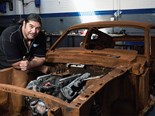Muscle Car Factory: Eleanor Build no.4





|

|
Getting the Eleanor Fastback replica looking nice is one thing, making it so it lasts is a whole other story. We visit Muscle Car Factory in Melbourne as they prep the body for painting
Muscle Car Factory Eleanor Replica Build
Last time we left Leo, he was just getting his head around the damage done by a severe factory fire that forced a move to new premises.
That put a bit of a dent in his business, but clearly it was far from fatal, as the crew at the Muscle Car Factory are up and running a again, with several projects on the go. At this stage we’re prefitting and assembling the body in preparation for painting. We’re still a long way of applying colour and this process can take several weeks.
"You look at some of the American restoration shows and you’ll see they use filler pretty much from edge to edge on the car. We try not to do that," explains Leo. "We start with new sheet metal and we make sure the joins are fully and welded and plugged before we look at any filler work.
"Being all brand new panels from Taiwan, they’re really nice quality to at least 98 per cent perfect. We make sure they’re good before we even start. You still have to tweak them, make sure the gaps are right, weld the edges a little and cut your own gaps.
"That said, at least you’re not dealing with heavy duty rust. I’ll tell you what happens: people want to use an original door on a Mustang, which tends to rust out on the front bottom.
There’s a little cavity there with a triangle reinforcement where it holds the hinges and it always rusts through. You’ll cut that section out, make a beautiful piece up, fold it round the door and you’ll find in two years’ time it will rust through again! The reason for that is you’ll never be able to get to that repair on the inside. As soon as you start welding, it oxidises, and creates a big heat spot. And that heat spot will rust.
"I would rather use brand new doors that have never seen water, cavity wax the whole area and it will never rust – they were never like that from the factory. I’d rather put the time into getting the gapping and finish right, rather than sit there having to deal with rust. Done properly, these cars will last longer than the originals.
"With the final product, it’s profiling that’s critical. We spend a lot of time profiling the doors to fenders, guards to quarter panels, quarter panels to boot lid. It’s about profiles and the gaps, which should be about 5-6mm in the end product, but you have to allow for the gap closing as you fill and paint the car.
"An example is the wheel arch flares. They’re coming out at a 30 degree angle, so you’re talking maybe a 2mm bonding surface. That will eventually flex and crack. We make an internal shelf. We’ll fold up a 30 by 20mm bit of sheet metal and contour it to the quarter panel , sit the flare up to the lip and make an internal shelf of steel, so it’s got 30mm holding it and will never break.
"A lot of the cars out there look great when they’re first painted. But literally the first time they hit the road you see the cracks starting to form.
"There are certain performance parameters this car needs to meet and if you don’t reach them you cheapen the car and the industry. And you don’t create good resale value – something that can actually go up in value."
Painting is the next step, read all about it here.
Unique Cars magazine Value Guides
Sell your car for free right here
Get your monthly fix of news, reviews and stories on the greatest cars and minds in the automotive world.
Subscribe

.jpg)












